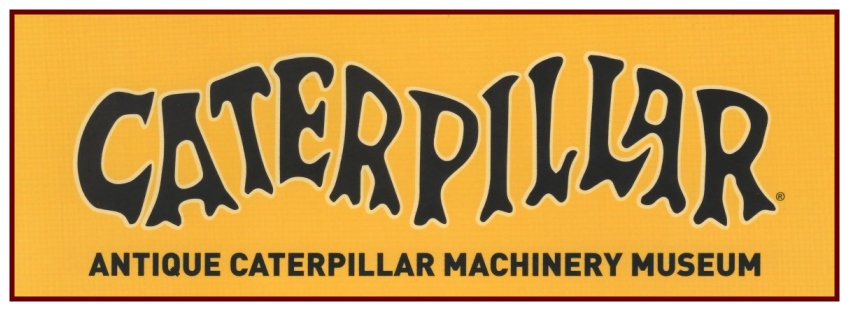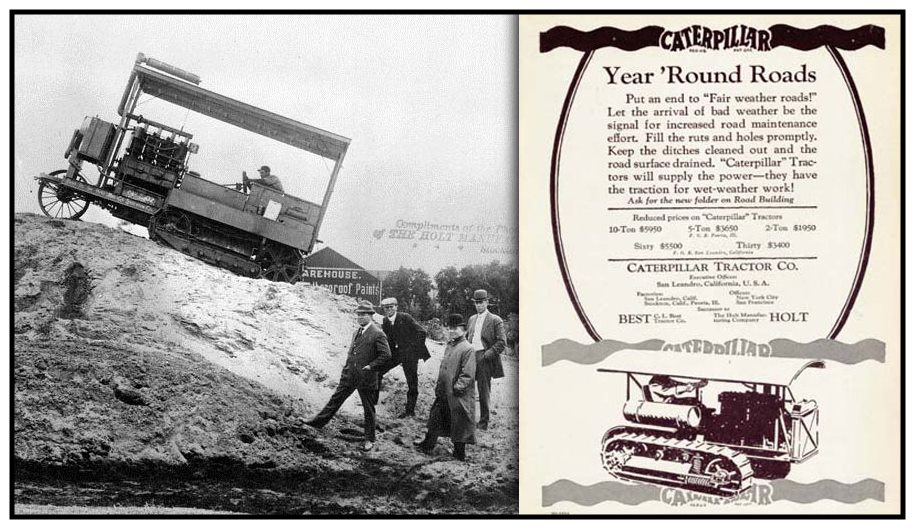 |
||||||||
|
Antique Caterpillar Machinery Museum |
||||||||
| Home | About Us | History | Events | News | Join Us | Merchandise | Contact Us | | ||||||||
|
History |
 |
||||||||||||||
 |
||||||||||||||
|
Porter Slate and Daniel Best |
||||||||||||||
In 1878, Porter Slate and Daniel Best built a steam-powered machine to push Slate's grain combine. Over a period of three years, they built five different machines, each an improvement over it's predecessor. The final version had rubber belts over the drive wheels, forming a type of track system.In 1881 Best, with Slates blessing, took the ideas they had developed and began a career that eventually led into the manufacturing of the Best Track-Type Tractor. |
||||||||||||||
 |
||||||||||||||
|
Benjamin Holt |
||||||||||||||
Benjamin Holt’s invention was inspired by the plight of California farmers who found wheels ineffective in preventing heavy equipment from sinking into the soft, muddy soil of the Stockton Valley. Holt designed a track-laying system to disperse weight and provide better traction, producing the prototype of the first practical track-type tractor in 1904. The photographer, who documented one of its first successful tests, dubbed the machine the “caterpillar,” inspiring the company name and launching the Caterpillar brand.Holt got heavily involved in road construction with the rise of the automobile in the early 20th century. The Holt 75 crawler with pull blade-graders was a regular workhorse in the nations "Good Roads" program. By 1915, Holt had put 2000 crawlers into service in more than 20 countries around the world. In 1916, Holt devoted its entire production of 5,000 machines to the war effort as modified "armed land destroyers" for WWI's Allied forces. After the war, Holt had to pick up the pieces of its neglected domestic market and regroup. Best stayed focused on farming, building wheel-type gas-powered tractors and experimenting with track-type tractors. In 1913, Best came out with the new 75 hp crawler, the first tractor bearing the "Tracklayer" trademark. They also offered a warranty on their tracks, ushering in the beginnings of product support and customer service. In 1919, the Best Sixty was introduced, becoming the most popluar tractor of the decade. They also had 15 Pacific Coast dealers by then, and 50 by 1924. |
||||||||||||||
 |
||||||||||||||
|
In 1925, the two companies decided to merge and pool their resources. Each brought complimenting assets to the table. Holt had the "Caterpillar" trademark name, the worldwide reputation, and bigger factories. Best had the better financial status, the more advanced tractor design and the beginnings of a better dealer group. The new company adopted Daniel Best's original plant in San Leandro as their first headquarters with C.L. "Leo" Best as the CEO and Chairman. Their prime products were the Best Thirty and Sixty; and Holt's 2-ton, 5-ton, and 10-ton machines. Sales rocketed in the first three years from $21 million in 1926 to $52 million in 1929 with profits at $4.3 million and $12.4 million respectively. By 1925, tractors (all) world-wide, reached the half-million mark and, by 1935, reached over one million. At the end of WWII there were roughly 2.5 million tractors on farms, which doubled with the post-war boom. The earthmoving era had definitely arrived. In 1991, Caterpillar was added to the Dow Jones Industrial group which consists of the 30 largest and most widely held public companies in the United States. Today, Caterpillar is the world's leading manufacturer of construction and mining equipment, diesel and natural gas engines and industrial gas turbines. In 2007, sales and revenues were $44.958 billion. James W. "Jim" Owens has been Caterpillar's CEO since 2004. |
||||||||||||||
 |
||||||||||||||
|